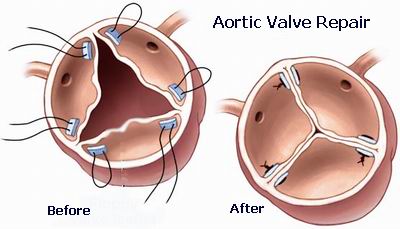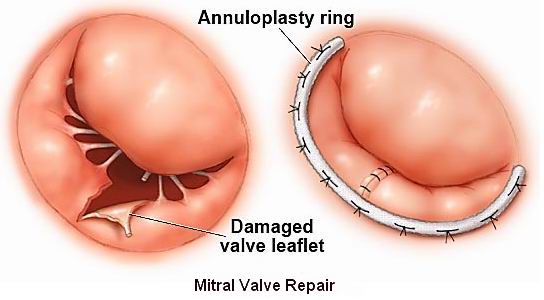
The mitral valve is one of the heart’s four main valves, located between the left atrium and the left ventricle. This valve is responsible for ensuring that blood flows in the correct direction—from the left atrium into the left ventricle—and prevents blood from flowing backward. When the mitral valve does not function properly, it can lead to a condition known as mitral valve regurgitation or mitral insufficiency, where blood leaks backward into the atrium. This condition can cause symptoms like shortness of breath, fatigue, and in severe cases, heart failure. Mitral valve repair is a surgical procedure aimed at fixing a malfunctioning mitral valve, rather than replacing it. When possible, repairing the valve is preferred over replacement because it tends to offer better long-term results, preserving the heart's natural function and minimizing complications. Mitral valve repair can restore normal blood flow, alleviate symptoms, and improve the overall function of the heart.
Mitral valve disease can result from several conditions that affect the structure and function of the valve. These include congenital issues, wear and tear on the valve, and damage caused by other heart conditions.

Causes of Mitral Valve Disease:
-
Mitral Valve Prolapse (MVP): A condition where the leaflets of the mitral valve bulge upward (prolapse) into the left atrium during each heartbeat. This can lead to regurgitation, as the valve does not close properly.
-
Rheumatic Heart Disease: A complication of rheumatic fever, which can damage the mitral valve, leading to stenosis (narrowing) or regurgitation. Rheumatic fever is caused by a streptococcal throat infection.
-
Endocarditis: An infection of the heart lining that can damage the mitral valve and lead to regurgitation.
-
Heart Attack: Damage to the heart muscle from a heart attack can alter the shape or function of the mitral valve, causing it to malfunction.
-
Degenerative Valve Disease: As people age, the mitral valve can become thickened, calcified, or weakened, leading to improper closure and regurgitation.
-
Congenital Defects: Some individuals are born with structural abnormalities in the mitral valve that lead to improper function.
Risk Factors:
-
Age: Older adults are more likely to experience degenerative mitral valve disease.
-
Family history: A family history of heart disease, particularly mitral valve disease, increases the likelihood of developing a similar condition.
-
High blood pressure: Chronic high blood pressure can strain the heart, causing wear and tear on the mitral valve.
-
Heart attack or heart failure: These conditions can damage the heart and affect the function of the mitral valve.
-
Infections: Infections like endocarditis and rheumatic fever can damage the mitral valve.
-
Connective tissue disorders: Conditions like Marfan syndrome or Ehlers-Danlos syndrome can weaken the mitral valve and lead to prolapse or regurgitation.
Identifying and addressing these causes and risk factors can help in managing and preventing the progression of mitral valve disease.
Symptoms of mitral valve disease can vary depending on the severity of the condition. Some individuals may not experience any symptoms, while others may have significant discomfort and complications. Common signs of mitral valve regurgitation or stenosis include:
Common Symptoms Include:
-
Shortness of breath: Difficulty breathing, especially during physical exertion or when lying down.
-
Fatigue: A general sense of tiredness or weakness, even with mild activities.
-
Heart palpitations: An irregular or rapid heartbeat, which may be felt as fluttering in the chest.
-
Chest pain or discomfort: Some individuals may experience sharp or dull chest pain due to increased workload on the heart.
-
Swelling in the ankles or feet: Fluid retention can occur due to heart failure resulting from severe valve dysfunction.
-
Coughing or wheezing: Chronic coughing or wheezing, particularly when lying down, can occur due to fluid accumulation in the lungs.
-
Lightheadedness or fainting: A drop in blood pressure caused by a malfunctioning mitral valve can cause dizziness or fainting spells.
Because these symptoms can be associated with other heart conditions, it is important to consult a healthcare provider for an accurate diagnosis.
To diagnose mitral valve disease and determine if repair is necessary, doctors typically use a combination of physical examinations, imaging tests, and diagnostic procedures.
Diagnostic Tests Include:
-
Physical examination: The doctor may hear a heart murmur during a routine examination, which may indicate mitral valve regurgitation. This is often the first clue that further testing is required.
-
Echocardiogram: The most common test to assess mitral valve function, an echocardiogram uses ultrasound to create images of the heart and blood flow. This test helps determine if the mitral valve is leaking (regurgitation) or narrowed (stenosis) and how severe the problem is.
-
Chest X-ray: A chest X-ray can help identify heart enlargement or fluid in the lungs, which are common signs of severe mitral valve disease.
-
Electrocardiogram (ECG): An ECG measures the electrical activity of the heart and can help identify abnormal heart rhythms caused by mitral valve problems.
-
Cardiac MRI: In some cases, a cardiac MRI is used to get a more detailed view of the heart’s structure and function.
-
Cardiac catheterization: In rare cases, a catheter may be inserted into the heart to measure the pressure inside the heart chambers and assess how well the mitral valve is functioning.
These diagnostic tests help doctors assess the severity of mitral valve disease and determine the best course of action, including whether mitral valve repair is appropriate.
Mitral valve repair is typically performed when the valve is defective but can still be repaired to restore its proper function. There are different approaches to mitral valve repair, including traditional open-heart surgery and minimally invasive techniques.
Steps Involved in Mitral Valve Repair:
-
Preparation: The patient is given general anesthesia to ensure they are asleep and pain-free during the procedure. A catheter is inserted to monitor the heart’s function throughout the surgery.
-
Incision: The surgeon makes an incision in the chest, typically through the breastbone (sternotomy), to access the heart. In some cases, minimally invasive techniques are used with smaller incisions.
-
Heart-lung machine: During open surgery, the patient is connected to a heart-lung machine that temporarily takes over the function of the heart and lungs, allowing the surgeon to operate on a still heart.
-
Valve repair: The surgeon will repair the mitral valve by:
-
Reshaping or tightening the valve: To ensure proper closure during each heartbeat.
-
Removing damaged tissue: To improve valve function.
-
Using a ring or stitch: To support the valve and improve its ability to seal properly.
-
-
Closure: Once the valve repair is complete, the heart is restarted, and blood flow is restored. The incision is closed with sutures.
-
Recovery: After surgery, the patient is monitored in the hospital for several days. Most patients can resume normal activities within a few weeks, though full recovery may take several months.
As with any surgical procedure, mitral valve repair carries certain risks. However, these risks are typically low, and the procedure has a high success rate. Some potential complications include:
-
Infection: Infections at the incision site or in the heart valve are possible.
-
Bleeding: Excessive bleeding may occur during or after surgery.
-
Valve dysfunction: In some cases, the valve may not function properly after surgery, requiring further intervention.
-
Blood clots: Blood clots may form during or after the surgery, increasing the risk of stroke or other complications.
-
Arrhythmias: Abnormal heart rhythms may occur, especially after heart surgery.
Your doctor will carefully assess your health and the condition of the valve to minimize these risks and ensure the best possible outcome.
After mitral valve repair surgery, most patients experience significant improvements in their symptoms. However, full recovery may take several weeks to months. During this time, it is important to follow the doctor’s instructions carefully.
Post-Surgery Recovery Tips:
-
Follow-up appointments: Regular visits to your healthcare provider are necessary to monitor recovery and ensure the valve is functioning properly.
-
Physical activity: Light activities and gradual exercise are usually recommended, but heavy lifting and strenuous exercise should be avoided for several weeks.
-
Wound care: Keeping the incision site clean and dry will help prevent infection.
-
Heart monitoring: The patient will likely undergo periodic echocardiograms and ECGs to ensure proper valve function and check for any complications.
Most individuals who undergo mitral valve repair can return to normal activities after a full recovery. This includes: Resuming physical activity and exercise (under medical supervision). Maintaining a healthy lifestyle with a balanced diet and regular check-ups. Mitral valve repair significantly improves quality of life by alleviating symptoms of heart failure and improving heart function. For patients who experience persistent symptoms or complications, additional treatment may be required, but most patients do well in the long term.
The other major cardiac procedures are:
Few popular hospitals for Mitral Valve Repair are:
Thailand, Malaysia, Singapore, Turkey and India are the most cost effective locations that offer up to almost 80% savings in comparison to the US.
SurgeryPlanet facilitates a plethora of services to the medical treatment traveler also which includes, a hassle free and discounted travel option, a welcome hand at the airport on arrival, travel in an air-conditioned car, round the clock service & support. Your medical evaluation is pre arranged with the least of waiting time. Once your assessment is complete and found medically fit, the procedure is immediately scheduled without a waiting period. Please read through our Services and Testimonials to understand and select your best options.
Heart Valve Problems | Leakage | Insufficiency | Regurgitation | Aortic Valve | Mitral Valve | Rheumatic Fever | Systemic Illness | Auto Immune Disease | Mitral Valve Prolapsed Syndrome | Mvp | Fatigue | Palpitations | Chest Pain | Anxiety | Imbalances In Autonomic Nervous System | Median Sternotomy | Cardiopulmonary Bypass | Heart Lung Machine | Annulus | Annuloplasty | Hospitals Mitral Valve Repair | Doctors Mitral Valve Repair | Surgery Mitral Valve Repair | Cost Mitral Valve Repair | Treatment Mitral Valve Repair | Destinations Mitral Valve Repair | Mitral Valve Repair India | Mitral Valve Repair Recovery | Mitral Valve Repair Information | Mitral Valve Repair Thailand | Mitral Valve Repair Malaysia | Mitral Valve Repairabroad | Mitral Valve Repair Overseas | Mitral Valve Repair Low Cost
SurgeryPlanet is an Healthcare Facilitator and not a Medical service provider. The information provided in this website is not to be used for diagnosis or treatment of any medical condition or use for any medical purposes. We provide information solely for medical travel facilitation and do not endorse any particular health care provider, hospital, facility, destination or any healthcare service or treatment listed. We are not an agent for, or affiliated to any health care provider, or service listed in our website and is not responsible for health care services provided by them. Choice of hospital or doctor for your healthcare services is your independent decision. Consult your domestic licensed health care provider before seeking the services of any health care provider you learn about from our website.


